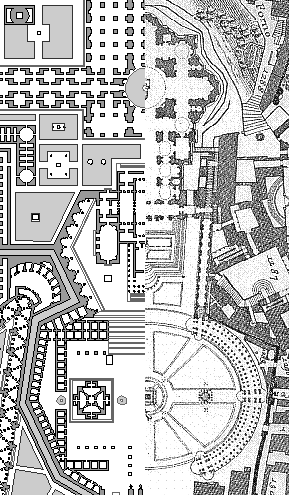2006.03.29 18:25
Depth
...Venturi may too have seen "that a characteristic of modern architecture, is a move away from depth" and thus worked to exploit that very aspect in his designs. Venturi may too have been inspired by the contemporary architecture being built in Rome while he was at the American Academy in the early 1950s.
One could also say that Kahn earlier introduced "depth" via volumetric geometrics and the "cut-outs" thereof, which, for a while, influenced Venturi and later Matta-Clark.
| |
2012.03.29 14:47
Re: Traditional Architecture
If ours is "an era of decadent, mass-produced, Orwellian mendacity about everything our culture is or aspires to be," then isn't that what our architecture should reflect?
2013.03.29 17:41
Is drawing dead?
...you just wrote something that uncannily relates to how I see my designing via CAD as different from how architects are generally taught to design. From virtually the very beginning, now 30 years ago, CAD has indeed made me want to "design by quickly throwing something together," and it's not to be fast and done, but to be that confident and actually good.
2014.03.29 13:58
Earlier this morning...
Earlier this morning was reading "A Conversation with Elia Zenghelis" in Log 30. Fun passage:
EZ: Yes, and that architecture existed for the city. Rem was already working on Delirious New York and was under the spell of Dalí, as the title reveals. Moreover, the book makes frequent use of aphorisms that are reminiscent of Dalinian expressions, especially in his romantic novel Hidden Faces, a story influenced by Stendhal. Dali had an enduring effect on the early OMA legacy. Certain of his statements are indicative of this: "At the age of six I wanted to be a cook. At seven I wanted to be Napoleon. And my ambition has been growing steadily ever since." "Intelligence without ambition is a bird without wings." "There are some days when I think I am going to die from a overdose of satisfaction." Its worth noting how frequently the word overdose is used in Rem's texts, as well as those of Rem's fans. And finally, "There is only one difference between a mad man and me. I am not mad."
| |
2014.03.29 17:22
29 March
Read this morning from “A Conversation with Elia Zenghelis” in Log 30:
CD: Charles Jencks called the Sphinx surrationalist architecture. Not surreal, but surrational. For Jencks, surrationalist was a neologism for the reunion of real urban function and existing urban fantasy. Was the Sphinx a union of function and fantasy, and did that make it surrationalist, as opposed to pure rationalism?
EZ: Charlie [Jencks] is a whiz-kid of isms and it is best left to him to decide on them. We were neither advocating nor opposed to any isms, but we did not adhere to any either—and Charlie’s would not be an exception. Equally, we were not necessarily opposed to pure rationalism; we just did not adhere to it. And we were certainly not against modernism, which we saw as an unfinished chapter.
Here we enter a whole discussion about “trends” and “factions.” I always feel uncomfortable with classifications. I disagreed with trends that searched for “newness,” as I believed there was nothing new to be discovered. For example, Archigram rejected rationalism as it had evolved, and they were moving away from what they saw as indoctrination, which they considered boring. In adopting a pop imagery, they were celebration consumerism.
But to go back to your question about the surrational: we did find surrealism inspiring for our purposes, as it inverts architectural drawing with a substitute reality, with hidden promises that are enigmatically calm and motivating. In the case of Dalí, what is often seen as cheap sensationalism is explained in The Secret Life of Salvador Dalí as the product of memory and moments of boredom. When children get bored they resort to imagination, they invent. Dalí recalls the walks that his nanny would take him on along the coast of Cadaques, where he grew up. The nanny would sit on the beach, ignoring him. In his intense boredom, Dalí would see a window carved out of her fat body, and inside that window, a fantastic and hallucinatory landscape would emerge that would mesmerize him. And there is an exact painting of this description. He also describes his memories as a growing embryo in his mother’s womb. It’s all beautifully described in a chapter about “intra-uterine memories.”
So I suppose what Charlie calls surrationalism could be an application of the same method to the processes of rationalism: a method by which a window of fantasy opens onto the landscape of reality
What strikes me most from within the above passage is Zenghelis saying “as I believed there was nothing new to be discovered.” I met Zenghelis at the 'Inside Density’ symposium, Brussels, November 1999—I presented a paper on Piranesi’s Campo Marzio and Eleni Gigantis, Elia’s wife, presented a paper after mine. We all met after presenting our respective papers, and the first thing Zenghelis said to me was, “You showed something new!”
He was referring to this . . . » » » »
17032901 Working Title Museum 005 @ Pantheon Paradigm model work 2379i21
17032902 IQ North Philadelphia East Girard East Housing Francisville Housing Dominican Fortress Girard Collage Mesh Surface City Blocks NPApraksin District plans 2093i68 b c
18032901 Palace of Versailles and Park working plans image 2092i25
18032901 OMA Audrey Irmas Pavilion Los Angeles
19032901 IQQ15 Berlin 1958 plans working data 1536 2468i46
19032902 IQQ15 Berlin 1958 plans working data 2468i477
21032901 icm iqq19 plus ultra plans 2110i211
21032902 icm iqq19 plus ultra garden of satire plans 2110i212
21032903 icm iqq19 plus ultra garden of satire apraksin @ bustum hadriani plans 2110i213
| |

|